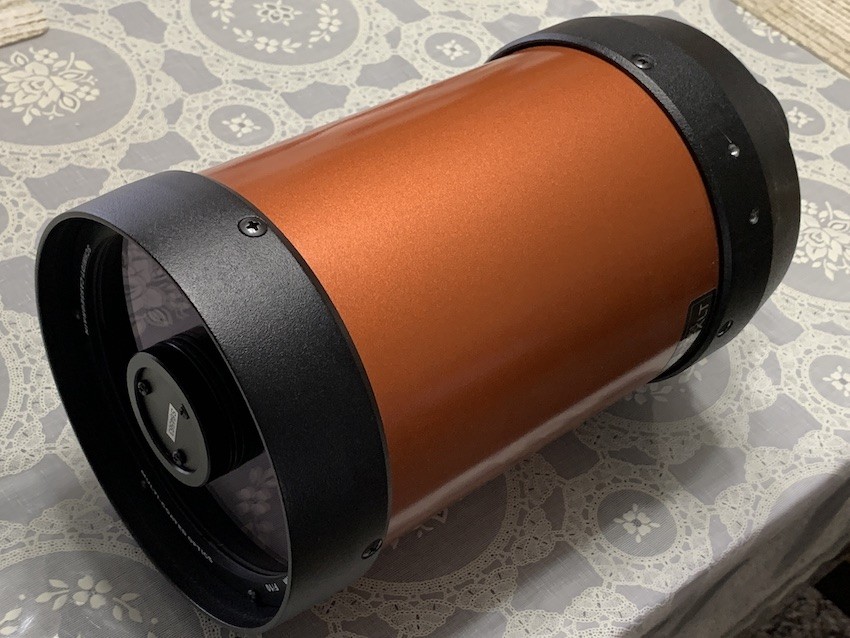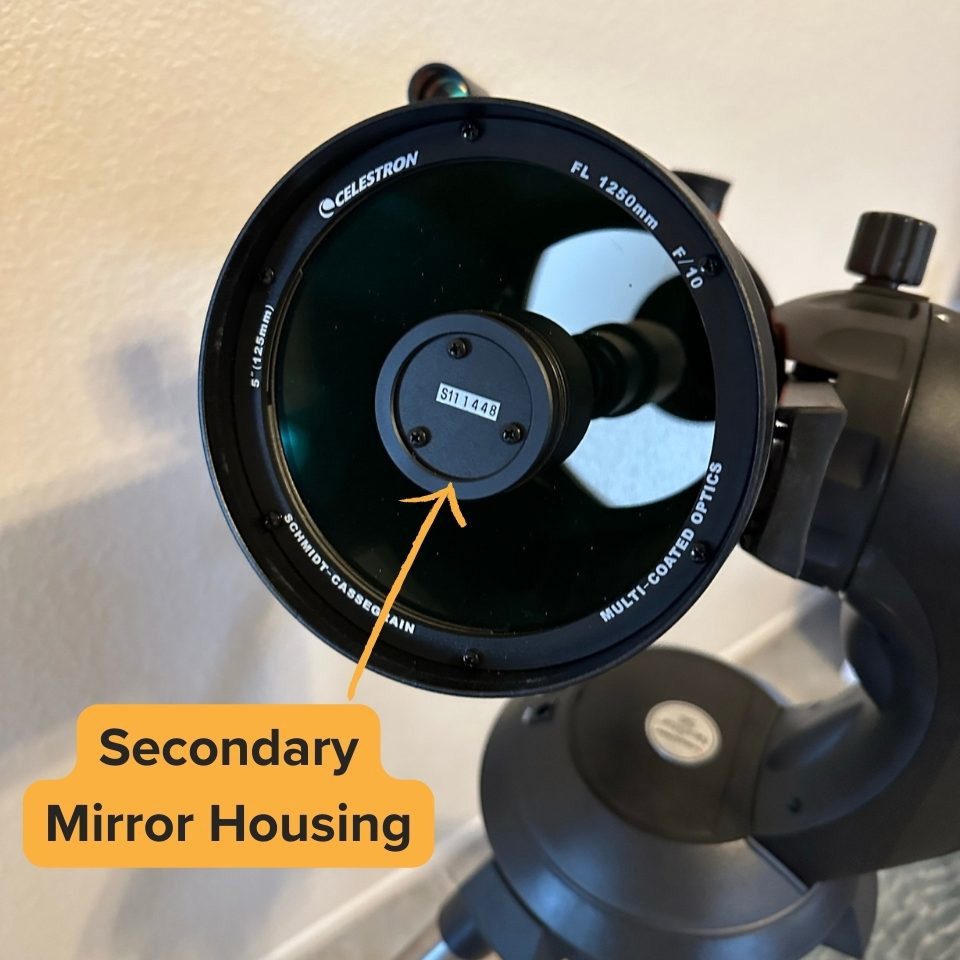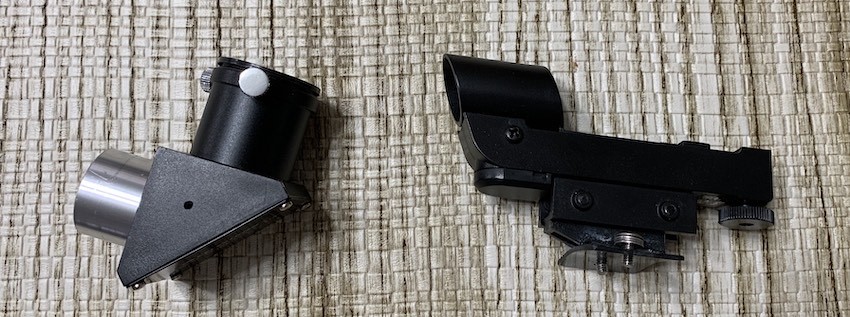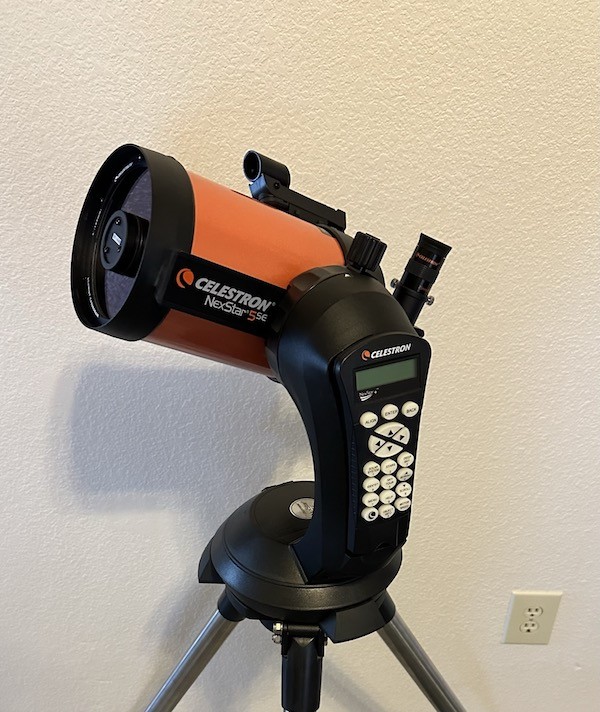Optical Tube Performance of Nexstar 5SE
The Celestron NexStar 5SE computerized telescope is based around the C5 optical tube, a telescope with 45 years of heritage that has even flown on Space Shuttle missions.

The C5 is a Schmidt-Cassegrain (SCT), which means that it does have a long focal length of 1250 mm, even though the physical length of the optical tube is short, as you can see in the above picture. The long focal ratio limits the telescope’s field of view somewhat, especially given that the scope comes with only 1.25″ eyepieces.
A 2” diagonal can, in fact, be attached to the 5SE if you want. But wide-field 2” eyepieces used with 2″ diagonals will vignette to the point that I don’t think it’s really worth the bother. The same was true when I tried using a dedicated f/6.3 focal reducer, an aftermarket accessory that is typically used to reduce an f/10 SCT to f/6.3 for astrophotography purposes. Unlike other Celestron SCTs, the C5 also lacks Fastar/Hyperstar capability, which are again popular aftermarket kits used for imaging purposes.

The Celestron NexStar 5SE’s 5” aperture is enough to show a fair amount of detail on the Moon and planets. But its large secondary mirror, which covers 38% of the diameter in the front, makes resolution and contrast much worse than with a 5″ Newtonian, Maksutov-Cassegrain, or refractor. It also reduces the light-gathering ability (already fairly small) by a fair amount.
As with most decent telescopes, the Celestron NexStar 5SE optical tube comes with a Vixen-style dovetail, which allows for easy, tool-free attachment and balancing on its mount, as well as numerous Celestron and third-party alt-azimuth and equatorial mounts that use Vixen saddles.
The 5SE does need to be collimated occasionally, as it is a Schmidt-Cassegrain.
Accessories: The Lone Plossl Eyepiece
The 5SE comes with a single 25mm 1.25” Plossl eyepiece, which provides 50x magnification, though you may want a 32mm Plossl and/or the aforementioned reducer-corrector for the widest field of view at low power.
The 5SE’s lone 25mm Plossl eyepiece really doesn’t allow us to get the most out of the telescope when it comes to high-resolution views of the Moon and planets. As such, I’d recommend a high-magnification eyepiece such as the 6mm “goldline” (208x).
For medium power, I’d use a 15mm goldline or a 15mm Agena Starguider for 83x.

Reviewing the Mount Features
The Celestron NexStar SE mount is an upgraded version of the original NexStar 5 mount, which was first released in the early 2000s.

It’s a simple alt-azimuth GoTo mount with a Vixen dovetail saddle that runs off fairly cheap servo motors.
The NexStar mount can point to over 40,000 objects in its database, the majority of which are simply stars and thus of little interest to the 5SE or any telescope. A good chunk of the deep-sky objects in its database are also unfortunately invisible with the Celestron NexStar 5SE telescope, on account of their meager brightness or being in the wrong hemisphere of the sky to be seen from your location.
While this whole design works, I’ve come across a few issues that are worth sharing with you:
- The hand controller’s small buttons make it all too easy for me to push the wrong one because I have fairly large fingers and/or simply because I have my gloves on.
- It also consumes batteries very quickly. I always need a 12-volt power supply to use this scope peacefully.
- The SE mount is pretty steady, but it can still be bumped. If this happens, I have to re-boot and realign the mount.
- Lastly, I have to enter the time and date every time I start up the mount, unless I use Celestron’s SkySync GPS accessory or their SkyPortal WiFi adapter with the scope. Both of these cost more than $100 each, if you want to buy one.
The SkyPortal WiFi adapter, if you buy one, also mitigates the annoyance and limitations of the scope’s traditional hand controller by allowing us to control the scope with our phone. But that’s again at the expense of drawing significantly more electrical power from our scope/battery as well as eating up our phone’s battery charge.
The Celestron NexStar 5SE comes with a built-in equatorial wedge, so in theory, one can polar align it and do long-exposure astrophotography. However, the wedge has no fine adjustments and cannot be adjusted in azimuth, so it is basically useless. Also, the low-precision gears on the mount and the long focal length of the 5SE make it a bad choice for long-exposure astrophotography.
Should You buy a Used NexStar 5SE?
A used Celestron NexStar 5SE is a decent scope.
Keep in mind that you will still have to buy additional eyepieces to get the most out of the 5SE unless the seller is nice enough to throw some in.
Alternative Recommendations
The 5SE isn’t awful, but I’d recommend other computerized telescopes—or a Dobsonian—in its place if possible.
The Celestron NexStar 5SE certainly isn’t my top pick in its price range. If you must have a telescope like it, at least consider the larger Celestron NexStar 6SE which has significantly more light-gathering and resolving power with virtually the same form factor and a slightly higher price. Alternatively, here are some of my even better top picks.
Under $1000
- The Apertura AD10/Zhumell Z10/Orion SkyLine 10 features 2x the resolving power and over 4x the light gathering ability of the 5SE thanks to its massive 10” primary mirror. You also get a variety of accessories, such as a 2” low-power, wide-angle eyepiece, a 9×50 finder scope, and a 9mm high-power Plossl eyepiece. The Dobsonian mount of the AD10 is easy to aim and much quicker to set up than the computerized 5SE mount, as well as more stable.
- The Apertura AD8/Zhumell Z8/Orion SkyLine 8 has largely the same features as the AD10/Z10, and offers 60% more resolution and 2.6x the light-gathering power of the NexStar 5SE, all mounted atop a sturdy and easy-to-aim Dobsonian base with the same great accessories as the other AD/Z series deluxe Dobsonians. However, if you can afford it, we’d recommend the 10” model due to its similar accessories, form factor, and portability, combined with its much greater capabilities.
- The Celestron StarSense Explorer 8” Dobsonian offers some computerized capability in the form of the StarSense Explorer technology, plus the vastly superior light gathering and resolving power of 8” of aperture on a sturdy Dobsonian base. The scope is easy to set up, transport, and use, though you don’t get a lot of accessories for the price compared to some other offerings.
- The Sky-Watcher Virtuoso GTi 150P offers a bit more light gathering ability and resolving power – plus a much wider field—than the NexStar 5SE, in a compact tabletop package that features GoTo and motorized tracking like the 5SE but can be aimed manually and is controlled with your smartphone or tablet rather than a handset/keypad. The Virtuoso GTi 150P is also available in a manual configuration as the Sky-Watcher Heritage 150P, which is identical apart from its lack of electronics.
- The Celestron Astro Fi 130 has a similar amount of light gathering power and resolution to the NexStar 5SE, but provides a much wider field of view thanks to its 650mm focal length and ability to accept 2” wide-angle eyepieces. The Astro Fi mount is controlled via your smartphone or tablet instead of a hand controller, and the Astro Fi 130 comes with two eyepieces instead of the single one supplied with the NexStar 5SE.
$1000-$1400
- The Apertura AD12/Zhumell Z12/Orion SkyLine 12 features immense capabilities compared to the 5SE – nearly six times as much light gathering ability and 150% more resolution. Like the smaller AD/Z series deluxe Dobsonians, the AD12/Z12 includes a variety of great features and accessories. The only caveat with this excellent telescope is that we would recommend you consider your storage and transport options carefully due to its massive size and weight compared to a smaller 8” or 10” scope.
- The Celestron StarSense Explorer 10” Dobsonian features quadruple the light gathering ability and double the resolving power of the 5SE, with the bonus of Celestron’s StarSense Explorer technology to aid you in finding your way around the night sky. Like the 8” model, you don’t get a lot of accessories with this scope, but the cutouts in the base and handles on the tube help significantly with transporting it.
- The Celestron NexStar 6SE is superficially similar to the 5SE, but the 6” optical tube offers more light gathering ability and resolving power than the 5SE, along with a smaller secondary mirror obstruction and HyperStar compatibility, atop a steadier mount, and a minimal increase in weight, bulk, or price. If you are insistent on the 5SE, we would highly recommend you bite the bullet and pay a bit extra for the 6SE. It is vastly more capable and much better value for the money.
Aftermarket Accessory Recommendations
The Celestron NexStar 5SE could really use a dew shield. A dew shield is just a flat black plastic or rubber cylinder that goes on the front of the telescope, blocking out stray light and preventing dew or frost from forming on the corrector lens, which can fog up the view as well as eat away the coatings over time.
You can make one yourself or buy one from AstroZap.
What can you see with the Celestron NexStar 5SE?
The 5SE’s small aperture and narrow field of view make it primarily a lunar, planetary, and double star instrument.
- It shows us lunar craters and mountains just a few miles wide, the phases of Venus and Mercury, the cloud belts of Jupiter and Saturn, Jupiter’s Great Red Spot and the Cassini Division in Saturn’s rings, and the two gas giants’ various moons. I could also see Uranus and Neptune as bluish, star-like dots.
- Under clear and steady skies, the NexStar 5SE also has no trouble splitting double stars as close as an arc second apart.
As for deep-sky objects, the Celestron NexStar 5SE’s small aperture is the biggest limiting factor, even under dark skies.
- I could spot most of the objects in the Messier catalog and view globular clusters and galaxies, but resolving individual stars in globular clusters as well as details in most galaxies, such as spiral arms or dust lanes, was challenging, even when I’m under dark skies far from light pollution.
- From the suburbs, the 5SE disappoints in all but the brightest nebulae and star clusters, such as M42, M27, and M13.




Hi,
How are you! I’ve been spending some time reading your reviews and learned a few things, still I’d like to ask you your advice on a delicate purchase. We’d like to offer a telescope to our parents for their both 70th anniversary and we don’t really know what to look for. I’d like for them to be a nice experience, not to heavy to carry and where they don’t spend too long looking for what they want.I see your recommend quite a lot of Dobsons but I don’t think it such a good option since I imagine it could become an exterior activity for them carrying the telescope with them in fields far away from the city lights. I was quite tempted by a Celestron Nexstar 5 SE and I see you don’t recommend it and advice more for 6 SE, is this a good one? I also saw those ones, could you please advice me for the onde you would consider to be the best option or if you have any other recommendations? Thanks a lot for your support and congratulations for the excellent work!
Nexstar SLT Maksutov 127
SkyWatcher MAKSUTOV 127/1500 sur AZ SynScan goto
Celestron Nexstar SLT N 130
SkyWatcher Black Diamond 200/1000 sur NEQ5 + Crayford
I would get a Dob or the Black Diamond
If the Nexstar 5se was priced about $500, would it be a better value/ranking?
The 6SE or an Astro-Fi 130 still provide superior value